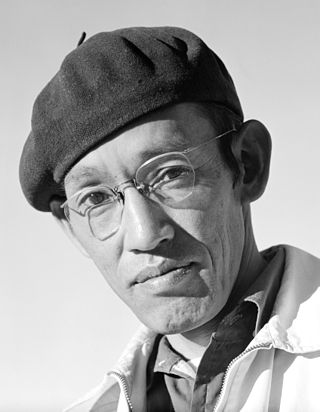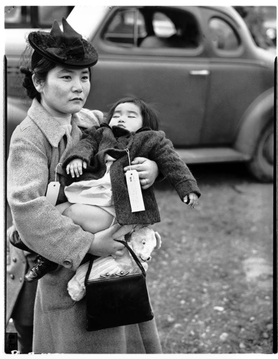Strawberry Fields may refer to:
Kerri Sakamoto is a Canadian novelist. Her novels commonly deal with the experience of Japanese Canadians.

Yuri Kochiyama was an American civil rights activist. Influenced by her Japanese-American family's experience in an American internment camp, her association with Malcolm X, and her Maoist and Islamic beliefs, she advocated for many causes, including black separatism, the anti-war movement, reparations for Japanese-American internees, and the rights of political prisoners.

The Poston Internment Camp, located in Yuma County in southwestern Arizona, was the largest of the 10 American concentration camps operated by the War Relocation Authority during World War II.

Tōyō Miyatake was a Japanese American photographer, best known for his photographs documenting the Japanese American people and the Japanese American internment at Manzanar during World War II.

Suzy Nakamura is an American actress and improv comedian. She is known for her many guest appearances on sitcoms such as According to Jim, Half and Half, 8 Simple Rules, Curb Your Enthusiasm and How I Met Your Mother and her recurring role in the early seasons of the drama The West Wing as assistant to the Sam Seaborn character, as well as Dr. Miura in the ABC sitcom Modern Family and Karen in the Netflix series Dead to Me. She had leading roles in the television shows Dr. Ken and Avenue 5.
Dan Kwong is an American performance artist, writer, teacher and visual artist. He has been presenting his solo performances since 1989, often drawing upon his own life experiences to explore personal, historical, and social issues.
Takayo Fischer is an American stage, film and television actress, as well as voice-over actress.
Rea Tajiri is an American video artist, filmmaker, and screenwriter, known for her personal essay film History and Memory: For Akiko and Takashige (1991).

American Pastime is a 2007 fictional film set in the Topaz War Relocation Center, a Utah prison camp which held thousands of people during the internment of Japanese Americans during World War II.
Tsuyako "Sox" Kitashima was a Japanese-American activist noted for her role in seeking reparations for Japanese American internment by the United States government during World War II, particularly as investigated by the Commission on Wartime Relocation and Internment of Civilians in the 1980s.
The Pacific Citizen (P.C.) is a national, award-winning semi-monthly newspaper based in Los Angeles, California, United States. The P.C. has been providing the leading Asian Pacific American (APA) news to the community since its inception in 1929. The newspaper is published by the Japanese American Citizens League, JACL, which is the nation’s oldest and largest APA civil rights organization.
Honouliuli National Historic Site is near Waipahu on the island of Oahu, in the U.S. state of Hawaii. This is the site of the Honouliuli Internment Camp which was Hawaiʻi's largest and longest-operating internment camp, opened in 1943 and closed in 1946. It was designated a National monument on February 24, 2015, by President Barack Obama. The John D. Dingell, Jr. Conservation, Management, and Recreation Act, signed March 12, 2019, redesignated it as Honouliui National Historic Site. The internment camp held 320 internees and also became the largest prisoner of war camp in Hawaiʻi with nearly 4,000 individuals being held. Of the seventeen sites that were associated with the history of internment in Hawaiʻi during World War II, the camp was the only one built specifically for prolonged detention. As of 2015, the new national monument is without formal services and programs.
William Minoru Hohri was an American political activist and the lead plaintiff in the National Council for Japanese American Redress lawsuit seeking monetary reparations for the internment of Japanese Americans during World War II. He was sent to the Manzanar concentration camp with his family after the attack on Pearl Harbor triggered the United States' entry into the war. After leading the NCJAR's class action suit against the federal government, which was dismissed, Hohri's advocacy helped convince Congress to pass legislation that provided compensation to each surviving internee. The legislation, signed by President Ronald Reagan in 1988, included an apology to those sent to the camps.

The Bainbridge Island Japanese American Exclusion Memorial is an outdoor exhibit commemorating the internment of Japanese Americans from Bainbridge Island, Washington. It is located on the south shore of Eagle Harbor, opposite the town of Winslow. Administratively, it is a unit of the Minidoka National Historic Site in Idaho. The mission of the memorial is Nidoto Nai Yoni, which means “Let It Not Happen Again”.

Fumiko Hayashida née Nishinaka was an American activist, originally from Bainbridge Island, Washington, who became one of the first Japanese Americans to be interned in March 1942. Hayashida was the subject of a Seattle Post-Intelligencer photograph which shows her, 31-years-old, holding her sleeping 10-month-old daughter, Natalie, while waiting to board a ferry from Bainbridge Island to the mainland with other Japanese American internees. The photo became an iconic image of the plight of approximately 120,000 Japanese Americans who were interned during World War II following the signing of Executive Order 9066. However, the identity of the woman in the photograph remained unknown for decades. She was known only as "Mystery Girl" or "Mystery Lady" until the 1990s, when researchers at the Smithsonian Institution uncovered her identity and tracked her down.
History and Memory: For Akiko and Takashige is a 1991 documentary film by Rea Tajiri. In her film, Tajiri recalls her family's experience of the American internment of the Japanese during World War II.

Lillian Baker was a conservative author and lecturer. She is known for supporting Japanese-American Internment throughout her career.

Miiko Taka was an American actress, popular for her film and television roles from the late 1950s until the early 1980s. Her best known role was as an elegant Japanese dancer starring with Marlon Brando in the drama Sayonara. She also acted in several other films and TV shows with fellow performers such as Miyoshi Umeki, James Garner, Bob Hope, Cary Grant, and Toshirō Mifune.









